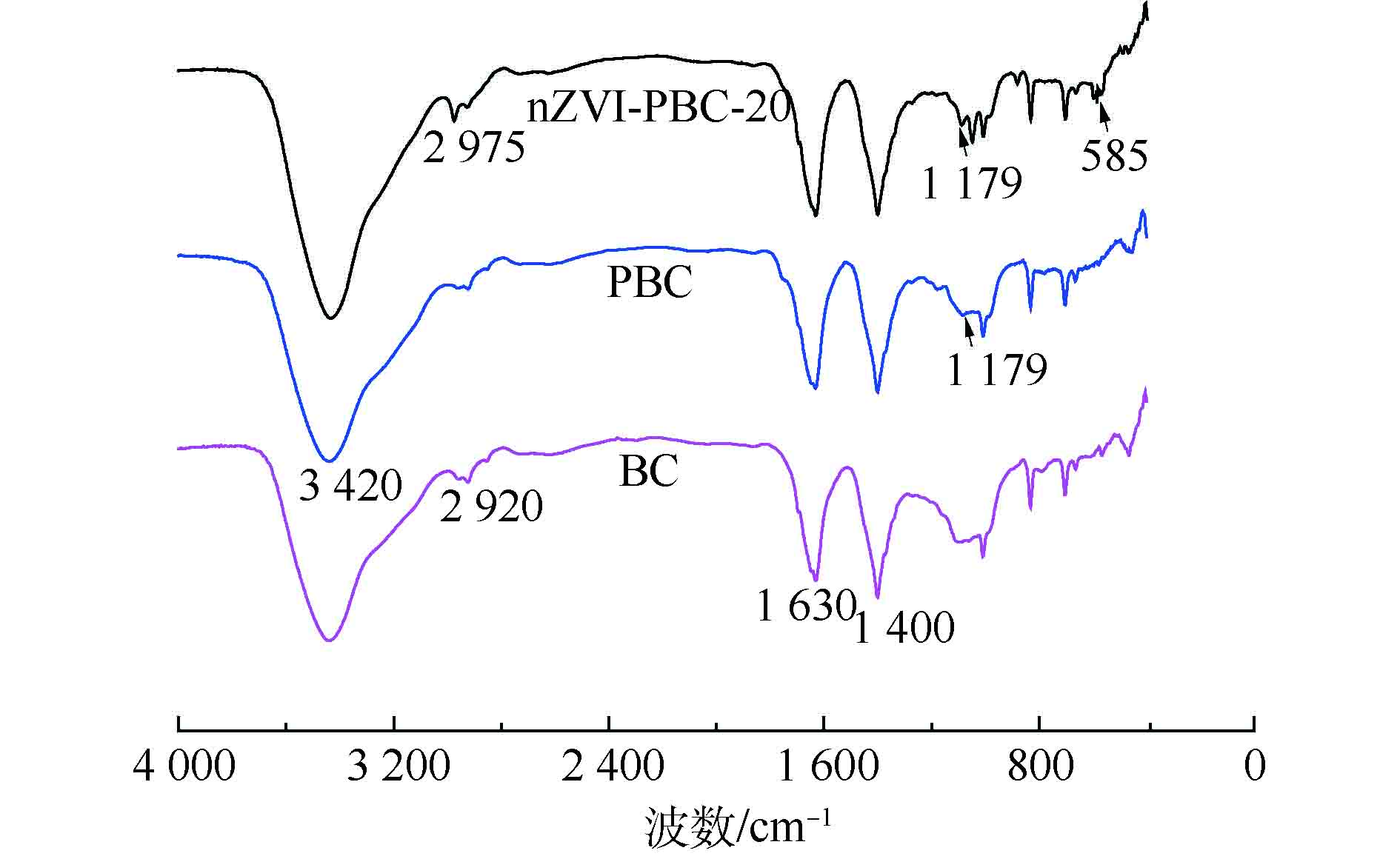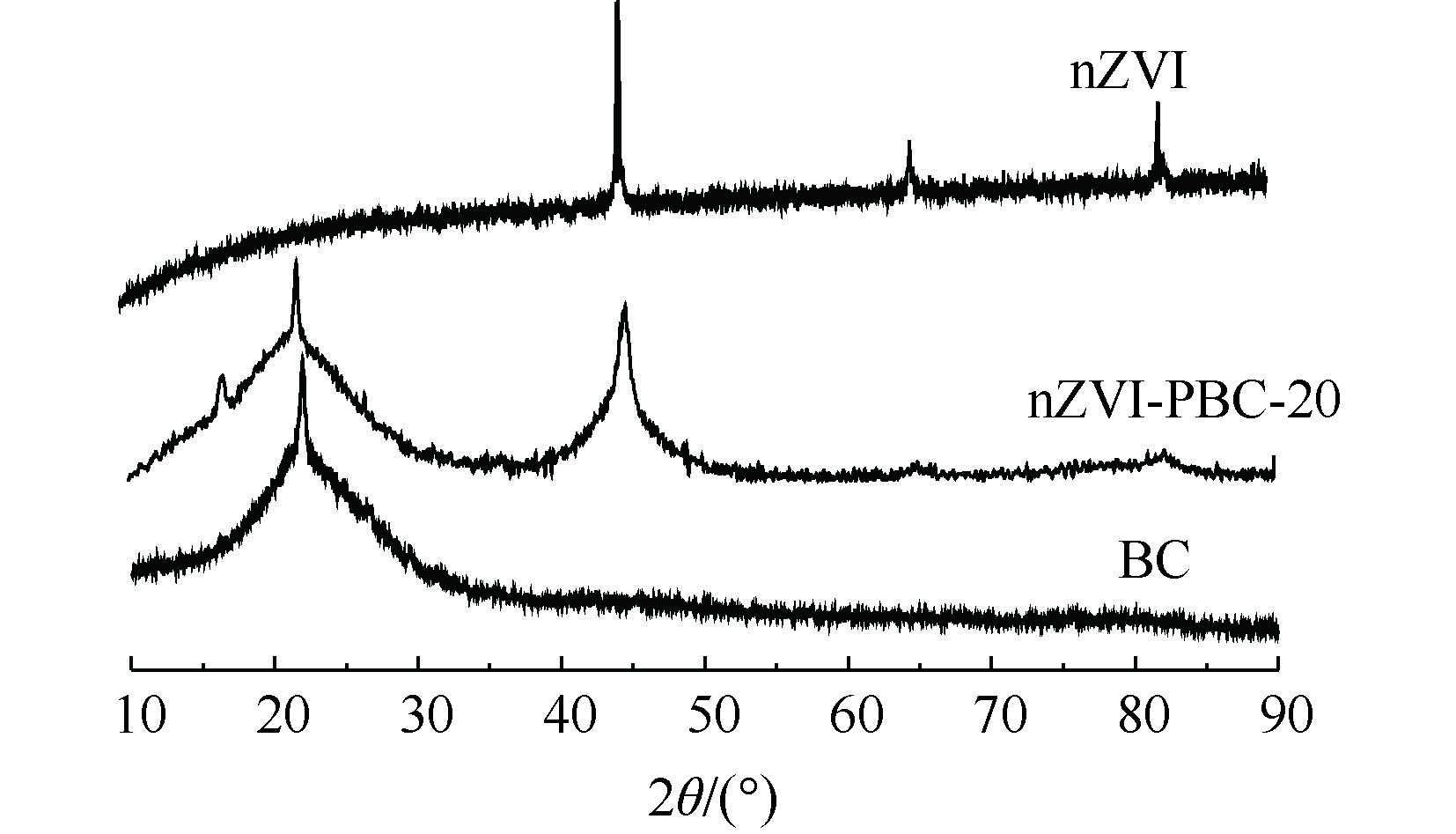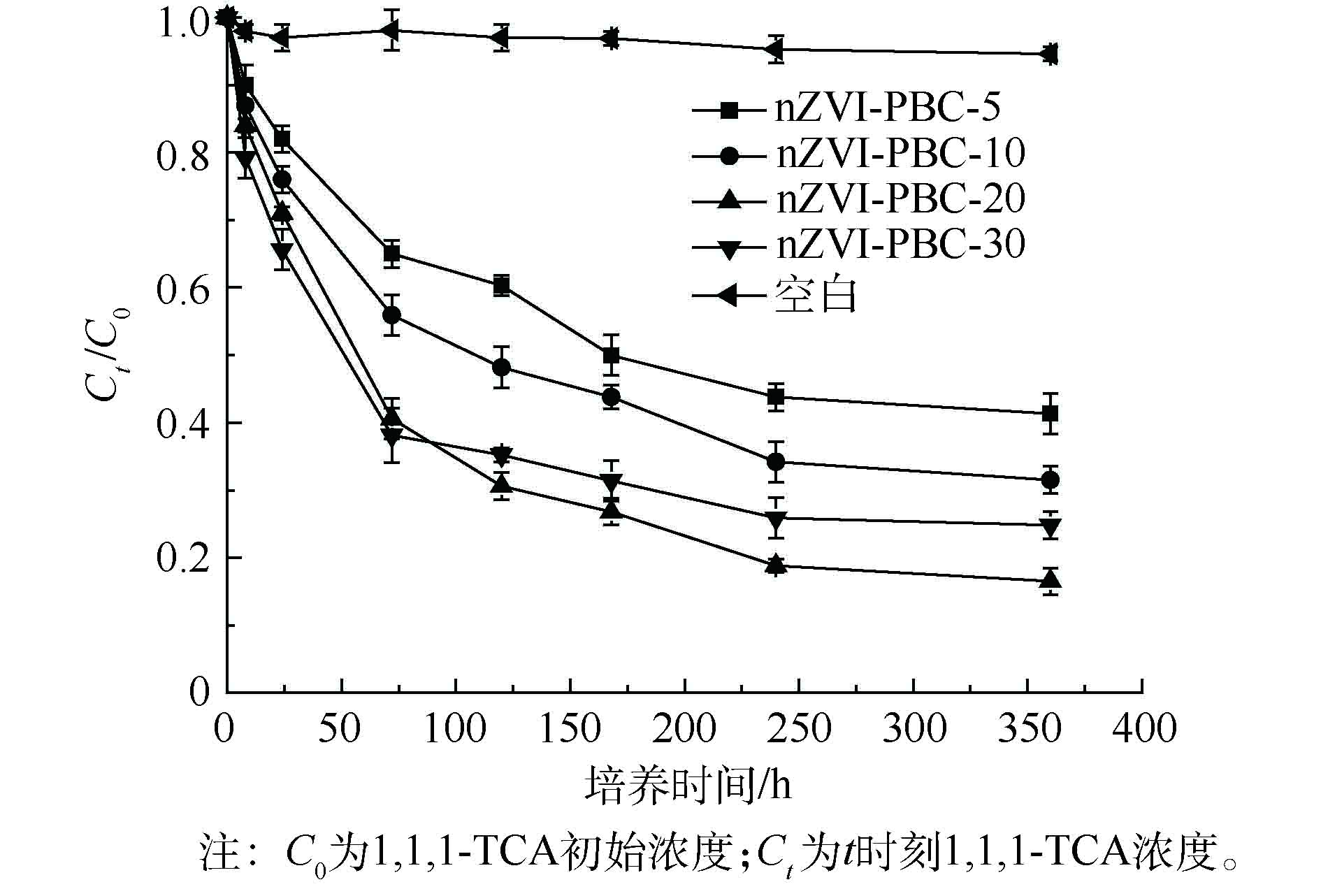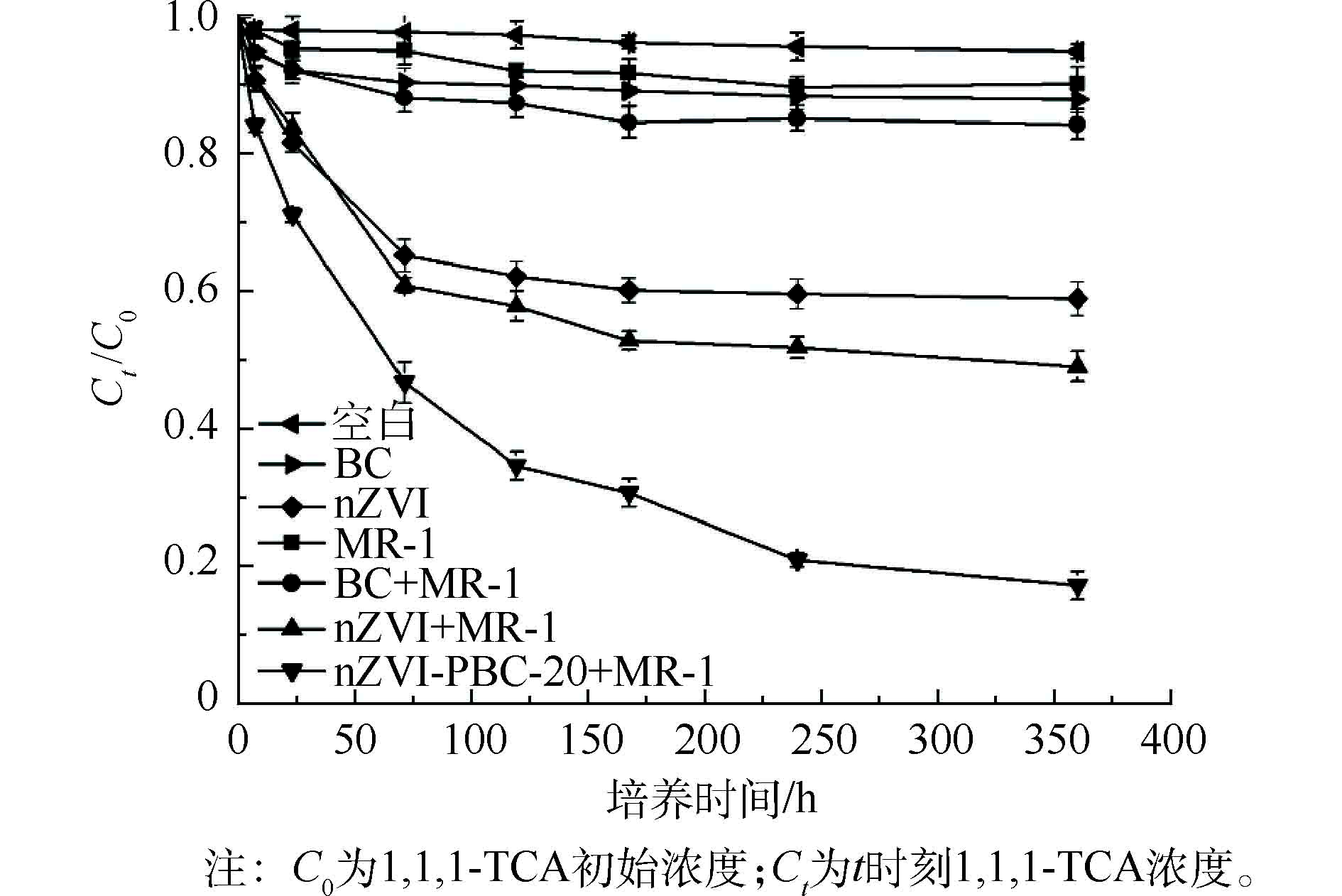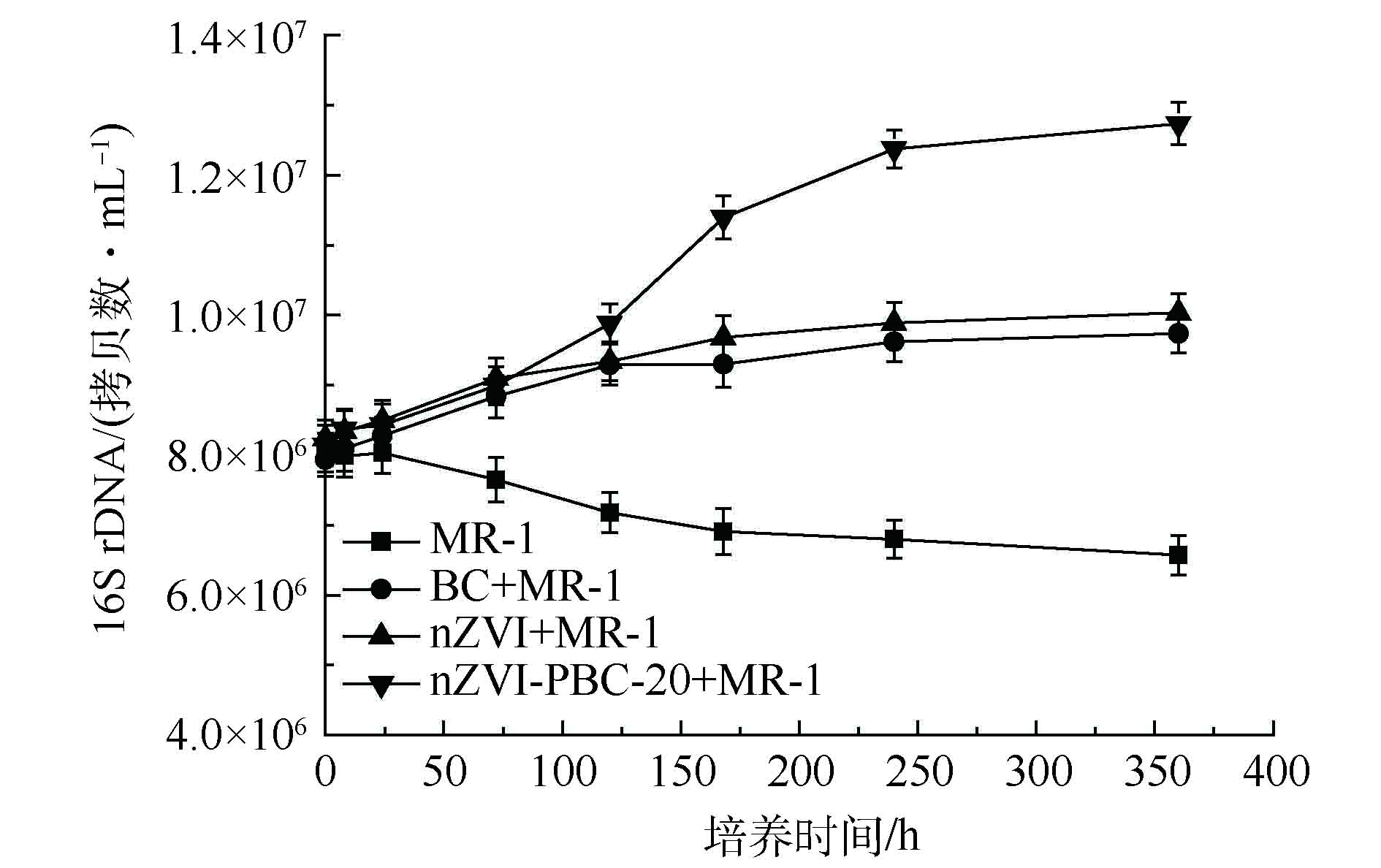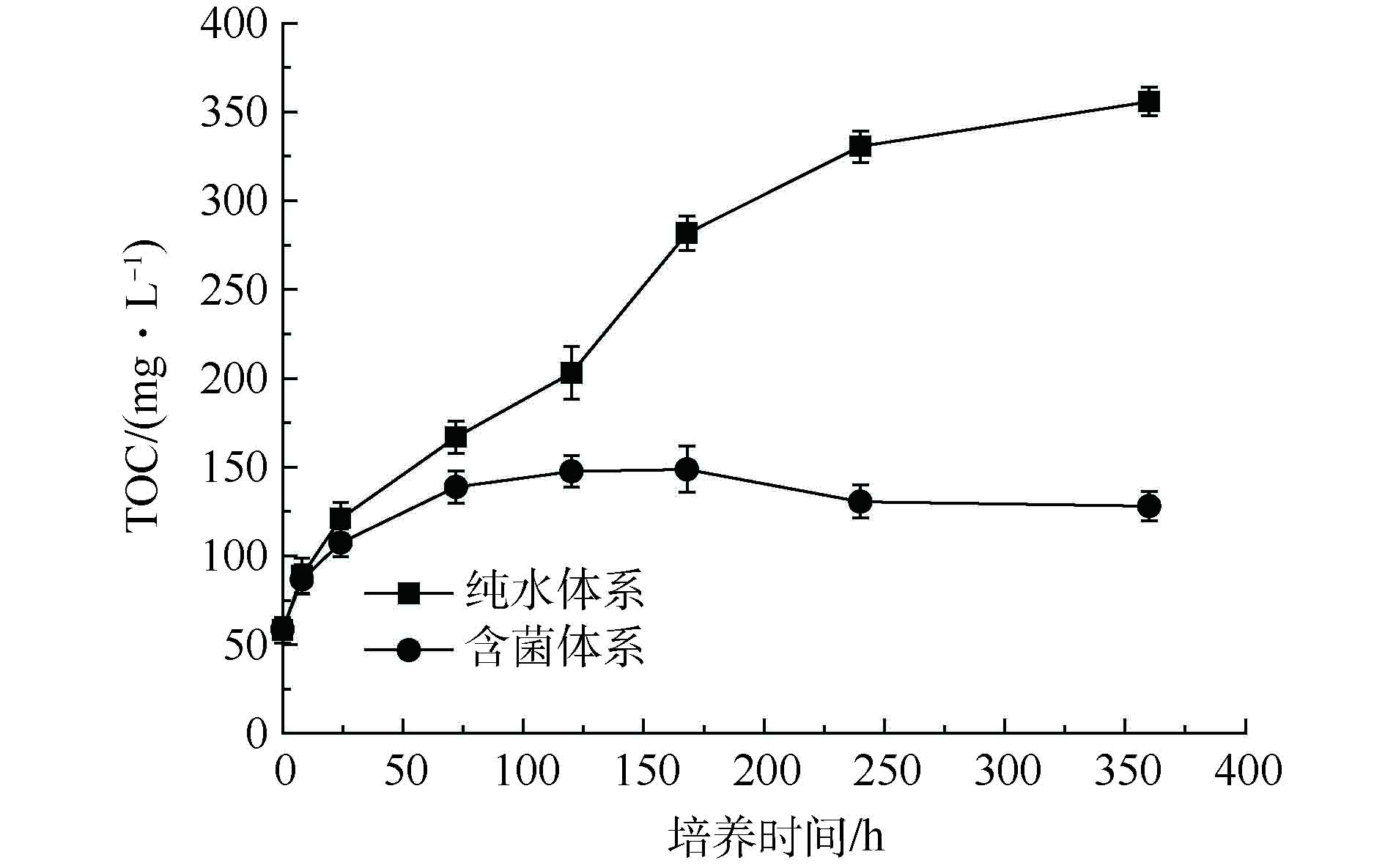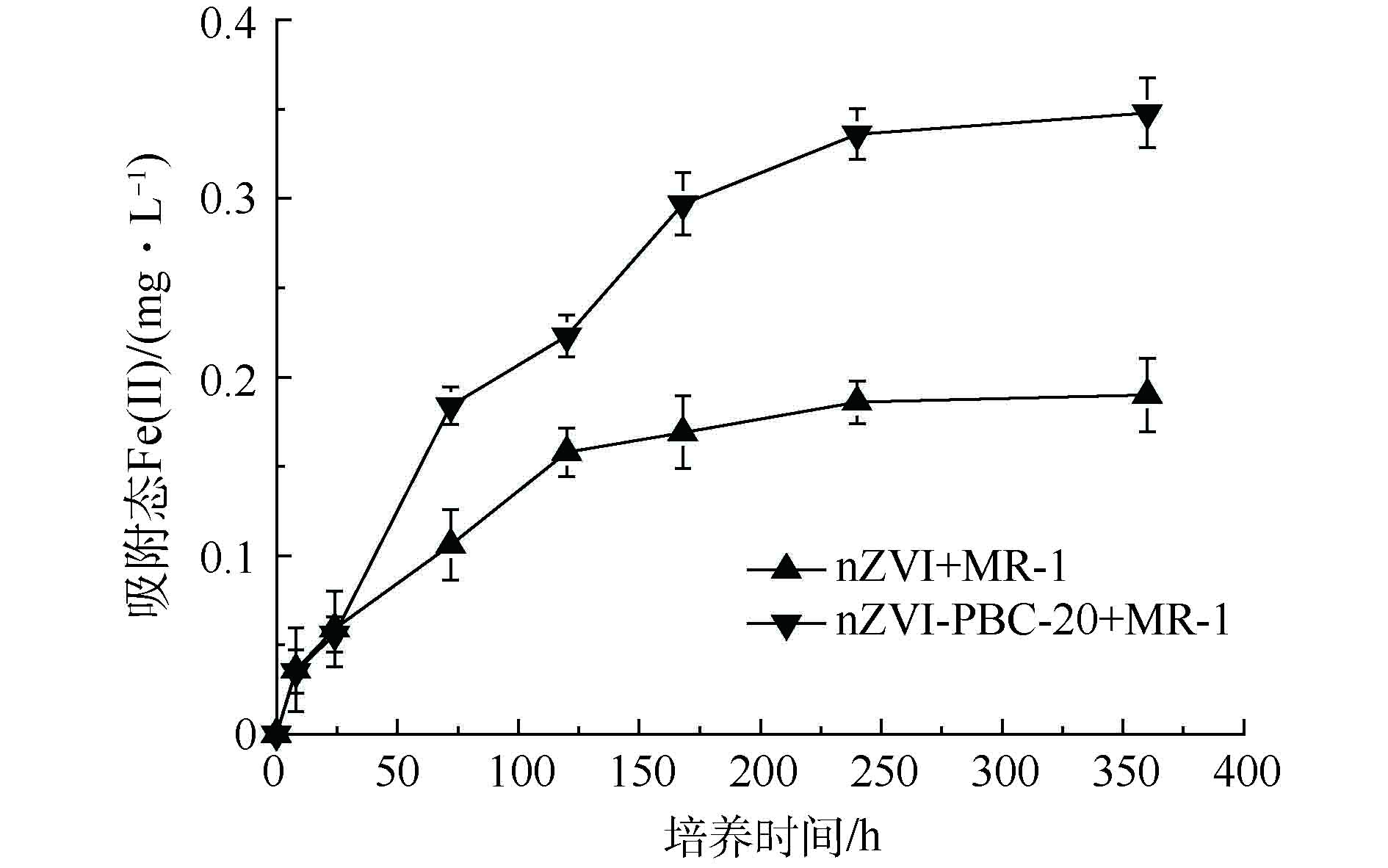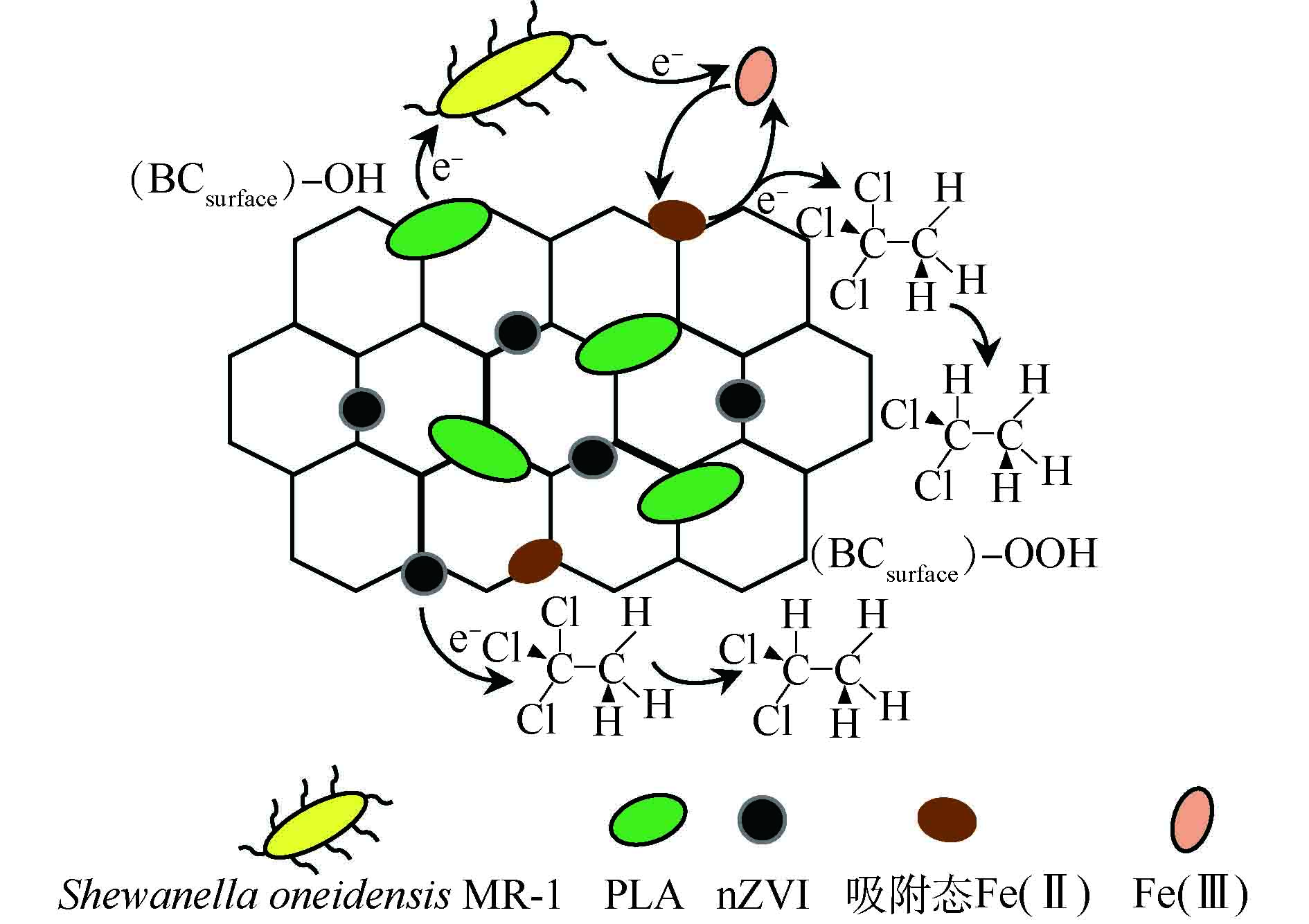-
1, 1, 1-三氯乙烷(1, 1, 1-trichloroethane, 1, 1, 1-TCA)是一种常见的有机氯溶剂,工业上的广泛使用和不当处置使其成为全球地下水中普遍检出的污染物之一[1]。1, 1, 1-TCA易迁移扩散,化学性质稳定且不易降解,并具有“三致”效应,其一旦进入地下环境,将会严重危害生态安全和人类健康[2-3]。因此,如何高效治理1, 1, 1-TCA污染地下水已成为环境修复领域的研究热点。
原位强化还原脱氯是一种有效修复氯代烃污染地下水的方法,其中修复材料是影响修复效果的关键因素[4]。目前较为常用的修复材料包括具有化学还原脱氯能力的零价铁,以及能够促进微生物还原脱氯的有机碳源[5]。但这些修复材料存在易团聚和氧化、作用时效短及利用效率低等问题,从而限制了其应用范围[6-7]。设计并制备高效的功能复合材料是解决上述问题的一个新途径[8]。
将零价铁负载于生物炭(biochar,BC)上可显著降低零价铁的团聚程度,提高其对氯代烃的化学脱氯效果。DONG等[9]制备了一系列纳米零价铁基生物炭材料,发现其对水中三氯乙烯的去除率比单一纳米零价铁高14%以上。同时,生物炭具有丰富的孔隙结构,能够有效吸附污染物[10]。然而,生物炭中生物可利用性碳含量较低,无法进一步促进微生物的还原脱氯作用[11]。聚乳酸(polylactic acid,PLA)能够缓慢释放可被微生物利用的可溶性有机碳,是一种良好的缓释碳源[12]。因此,可以推测,将聚乳酸与负载零价铁的生物炭复合可增強材料的处理长效性。但目前有关这方面的研究尚未见报道。本研究制备了一种纳米零价铁-聚乳酸-生物炭复合材料,研究其协同胞外呼吸菌去除水中1, 1, 1-TCA的效果,并探讨协同体系还原降解污染物的机理。
-
试剂:芦苇秸秆生物炭,自制;1, 1, 1-三氯乙烷、聚乳酸、二氯甲烷、无水乙醇、哌嗪-1, 4-二乙磺酸(PIPES)、FeCl2·4H2O、NaBH4、HCl、NH4Cl、CaCl2、K2HPO4、KH2PO4等均为分析纯;研究所用胞外呼吸菌为希瓦氏菌(Shewanella oneidensis MR−1)的菌株,由中国海洋微生物菌种保藏管理中心提供。
仪器:离心机(TG16-WS型,上海卢湘仪离心机仪器有限公司);鼓风干燥箱(DHG-9070A,上海一恒科学仪器有限公司);分析天平(ML-T型,瑞士Mettler-Toledo公司);恒温振荡摇床(SPH-211B,上海一恒科学仪器有限公司);压力蒸汽灭菌器(BKQ-B75II,山东博科科学仪器有限公司)等。
-
1)生物炭(BC)的预处理。将BC过120目筛[13],用1.2 mol·L−1 HCl浸泡过夜以去除BC上杂质,去离子水冲洗至中性,烘干备用。
2)聚乳酸-生物炭(PBC)粉末制备。将1.0 g PLA溶于二氯甲烷后,加入7.0 g预处理后的BC,搅拌8 h,将混合液离心5 min(8 500 r·min−1),沉淀物用无水乙醇清洗数次,得到PBC粉末。
3)纳米零价铁-聚乳酸-生物炭(nZVI-PBC)复合材料制备。将4.0 g PBC粉末加入150 mL FeCl2·4H2O乙醇水溶液(24 g·L−1)中,搅拌30 min(200 r·min−1);在氮气保护下,将50 mL NaBH4溶液(55 g·L−1)逐滴加入上述溶液中,搅拌至反应完成,将沉淀依次用无氧去离子水及无水乙醇洗涤数次,冷冻干燥,得到Fe理论质量分数为20%的复合材料(nZVI-PBC-20)。按上述相同步骤,直接向FeCl2·4H2O溶液中滴加NaBH4溶液,制备得到纳米零价铁(nZVI)。
-
采用扫描电子显微镜(SEM)观察复合材料的形貌结构;采用同步热分析仪(TGA)测定材料中聚乳酸含量;采用傅里叶变换红外光谱仪( FT-IR)测定材料表面官能团;采用多功能X射线衍射仪(XRD)分析材料中铁的晶型;采用电感耦合等离子体质谱仪(ICP-MS)测定材料中铁含量[14-15]。
-
取0.8 g nZVI-PBC加入到80 mL灭菌去离子水中,置于恒温摇床中振荡(30 ℃,120 r·min−1),利用总有机碳仪定期测定水溶液中TOC浓度。
-
反应溶液配制:在1 L灭菌除氧去离子水中加入1.500 g NH4Cl、0.150 g CaCl2、0.225 g K2HPO4、0.225 g KH2PO4、5 mL微量元素储备液和5 mL维生素储备液[16],用50 mmol·L−1 PIPES缓冲液调节溶液pH至7.0左右,向上述厌氧培养基中加入一定体积的1, 1, 1-TCA,搅拌混匀,得到含一定浓度1, 1, 1-TCA的反应溶液。
菌悬液配制:Shewanella oneidensis MR−1菌体在30 ℃的LB液体培养基中活化12 h,离心5 min(8 000 r·min−1),灭菌去离子水洗涤3次,最终配制OD600=1.0的菌悬液于4 ℃待用。
1, 1, 1-TCA去除实验:本实验采用微培养体系,所有反应均在100 mL灭菌西林瓶中进行;在西林瓶中加入一定质量的复合材料,充氮后,加入78.4 mL一定浓度的1, 1, 1-TCA反应溶液和1.6 mL菌悬液(接种量为2%),西林瓶用丁基胶塞密封,置于恒温摇床中振荡(30 ℃,120 r·min−1)培养360 h,定期测定体系中1, 1, 1-TCA、吸附态Fe(II)和TOC浓度以及微生物数量。按照上述方法,分别考察复合材料组分配比、投加量和污染物浓度对材料处理效果的影响;同时,设置不同对照材料处理,以探讨复合材料协同微生物去除1, 1, 1-TCA的机理。每个处理均设置3个重复。
分析方法:采用吹扫捕集气相色谱质谱联用法(GC-MS)测定1, 1, 1-TCA浓度;采用邻菲罗啉比色法测定吸附态Fe(II);利用总有机碳仪测定TOC浓度;采用荧光定量PCR法测定微生物的16S rDNA数量[17-19]。
-
ICP-MS测定结果显示,复合材料nZVI-PBC-20中Fe的实际质量分数为20.35%,其与实验设定的材料中Fe的理论质量分数(20%)基本相符。
-
图1(a)和图1(b)分别为nZVI、BC、PLA及nZVI-PBC-20的热重曲线(TGA)与微商热重曲线(DTG),可以看出,BC和PLA存在1次热失重变化,nZVI-PBC-20存在2次热失重变化。nZVI-PBC-20和BC均在50 ℃左右出现1次热失重,主要是由于生物炭中的水汽及一些不稳定的灰分挥发导致的。nZVI-PBC-20还和PLA在280 ℃左右出现1次热失重,主要是由于聚乳的热分解导致的。同时,根据图1的数据分析可知,nZVI-PBC-20中PLA的质量分数为13.84%。
-
图2显示了BC、PBC和nZVI-PBC-20在扫描电镜下的形貌结构。由图2(a)可知,BC表面形貌较为光滑,孔隙结构丰富。由图2(b)可知,PLA以不规则颗粒状(0.5~3 μm)混于BC表面,增加了BC的粗糙程度,但并未明显覆盖其孔隙结构。该形貌特征有利于提高复合材料对污染物和微生物的吸附能力。由图2(c)可知,由液相还原生成的nZVI以球形颗粒状(50~150 nm)负载于BC表面,且分布较为均匀,但由于nZVI具有较大的比表面积,其在材料表面仍出现一定程度的团聚现象。
-
通过FT-IR分析复合材料的表面官能团特征。图3为BC、PBC和nZVI-PBC-20的FT-IR图谱。由图3可知,BC在3 420 cm−1和2 920 cm−1附近的峰分别对应于O—H和C—H的伸缩振动,而在1 630 cm−1和1 400 cm−1附近的峰则分别对应于BC芳香结构上C=C和C=O的伸缩振动[20]。与BC相比,PBC在1 179 cm−1附近出现了1个新的伸缩振动峰,其可能由PLA分子上C=O产生[21],这说明聚乳酸已与生物炭完成共混。nZVI-PBC-20与PBC的FT-IR图基本相似,但在585 cm−1附近出现1个新的较弱Fe—O伸缩振动峰,说明负载于材料表面的零价铁已在一定程度上被氧化。
-
通过XRD分析复合材料中Fe的晶型。图4为nZVI、BC和nZVI-PBC-20的XRD图谱。nZVI样品在2θ=44.8°处出现了明显的α-Fe0的特征主衍射峰,说明液相还原制备得到的纳米零价铁为体心立方结构[22]。BC样品在2θ=23.1°处出现明显的炭无定型结构特征峰[23]。nZVI-PBC-20样品则同时出现了上述2个特征衍射峰,表明纳米零价铁成功负载于生物炭上,这与复合材料的SEM分析结果相符。此外,nZVI-PBC-20样品在2θ=16.8°处出现1个新的特征衍射峰,其可能与复合材料中的聚乳酸有关。
-
不同组分配比复合材料对Shewanella oneidensis MR-1微培养体系中1, 1, 1-TCA的去除效果见图5。复合材料中PBC与nZVI质量比分别为19∶1、9∶1、4∶1和7∶3,依次表示为nZVI-PBC-5、nZVI-PBC-10、nZVI-PBC-20和nZVI-PBC-30。微培养体系中材料投加量为1.0%,1, 1, 1-TCA初始浓度为100 mg·L−1,并设置不添加材料和菌作为空白对照。
由图5可知,在添加nZVI-PBC-5、nZVI-PBC-10、nZVI-PBC-20和nZVI-PBC-30的体系中,1, 1, 1-TCA的最终去除率分别达到58.79%、68.52%、83.55%和75.27%,均高于空白对照,说明复合材料能够有效提高体系中1, 1, 1-TCA的去除效率。72 h内,各复合材料处理中1, 1, 1-TCA浓度均呈明显降低趋势,且材料中nZVI含量越多,其下降越快,这主要是因为纳米零价铁具有较强的化学还原能力,能够在短时间内脱氯降解1, 1, 1-TCA,且零价铁含量越多,还原速率越快[24];72 h后,各复合材料处理中1, 1, 1-TCA的降解速率均有不同程度变缓,这可能是因为纳米零价铁已在反应前期基本耗尽,污染物的降解主要由微生物的还原脱氯作用完成[25]。此外,72 h后,nZVI-PBC-20处理中1, 1, 1-TCA的残留率明显低于其余3个复合材料处理,这是由于此材料中丰富的零价铁在反应前期显著降低了污染物浓度,减轻了其对Shewanella oneidensis MR−1的毒害作用,同时材料中足够的生物炭(生长基质)和聚乳酸(碳源)进一步提高了菌的还原脱氯活性。由上述结果可知,nZVI-PBC-20的组分配比最优,即复合材料中BC、PLA和nZVI的质量比为7∶1∶2。
-
不同投加量复合材料协同Shewanella oneidensis MR-1对微培养体系中1, 1, 1-TCA的去除效果见图6。微培养体系中材料投加量分别为0.25%、0.5%、1.0%、2.0%,1, 1, 1-TCA初始浓度为100 mg·L−1,复合材料选择nZVI-PBC-20。由图6可知,随着材料投加量的增加,1, 1, 1-TCA的去除率不断提高,但当复合材料的投加量大于1.0%后,去除率的提高程度趋缓。如前所述,这是由于投加量较少时,材料中零价铁的化学还原脱氯作用以及生物炭和聚乳酸对Shewanella oneidensis MR-1活性的促进作用均较弱。综合考虑去除效果和成本因素,确定复合材料的最佳投加量为1.0%。
-
复合材料协同Shewanella oneidensis MR-1对微培养体系中不同浓度1, 1, 1-TCA的去除效果见图7。微培养体系中材料投加量为1.0%,复合材料选择nZVI-PBC-20。
由图7可知,当体系中1, 1, 1-TCA浓度分别为25、50、100和200 mg·L−1时,培养360 h后污染物去除率分别达到了94.61%、89.16%、85.62%和83.27%。这说明该复合材料协同Shewanella oneidensis MR-1对低、中、高浓度1, 1, 1-TCA均有良好的去除效果,可进一步应用于不同污染程度的有机氯溶剂污染场地修复。
-
进一步分析不同材料处理体系中1, 1, 1-TCA浓度、胞外呼吸菌16S rDNA数量、TOC浓度和吸附态Fe(II)浓度的变化情况,具体结果见图8~图11。微培养体系中nZVI-PBC-20投加量为1.0%,其余对照材料投加量与nZVI-PBC-20中相应组分在体系中的含量一致,1, 1, 1-TCA初始浓度为100 mg·L−1。体系吸附态Fe(II)浓度为体系总Fe(II)浓度减去溶液中Fe(II)浓度[26]。
如图8所示,360 h后,在nZVI-PBC-20 + MR-1处理体系中1, 1, 1-TCA的去除率达到82.98%,而BC和nZVI处理体系中1, 1, 1-TCA的去除效率分别为12.29%和41.11%,说明生物炭吸附和零价铁化学还原并不是复合材料协同胞外呼吸菌去除1, 1, 1-TCA的主要途径,材料刺激胞外呼吸菌产生异化铁还原脱氯可能起着重要作用[27]。由图9可知,不同材料处理体系中Shewanella oneidensis MR-1的数量均随时间延长而逐渐增加,且360 h后nZVI-PBC-20 + MR-1处理的数量增加最为明显,这是由于生物炭丰富的孔隙结构能为微生物提供良好的生长环境,同时零价铁在短时间内降低了1, 1, 1-TCA浓度,减少了污染物对微生物的毒害抑制作用[28-29]。如图10所示,添加nZVI-PBC-20的纯水中TOC浓度随时间延长缓慢增加,而含菌体系中TOC浓度则先增加后降低,这说明复合材料在水中具有良好的碳源缓释效果(由PLA的碳缓释特性产生),且所释放碳源能被胞外呼吸菌充分利用。综上可知,复合材料缓释碳源并刺激微生物生长是提高污染物去除效率的重要因素。
Shewanella oneidensis MR-1可利用吸附态Fe(II)产生异化铁还原过程,而异化铁还原对有机氯类污染物的降解具有重要作用[30]。由图11可知,nZVI-PBC-20 + MR-1和nZVI + MR-1处理体系中吸附态Fe(II)浓度均随时间的延长而增加;同时,2种材料处理体系中1, 1, 1-TCA的去除率均较高(图8),因此,可以认为零价铁对污染物还原过程中产生的吸附态Fe(II)刺激了Shewanella oneidensis MR-1的异化铁还原活性,从而提高了1, 1, 1-TCA的去除效果。XU等[26]研究表明,铁矿物上的吸附态Fe(II)同样能提高胞外呼吸菌对五氯酚的脱氯降解效果。
上述结果表明,复合材料协同胞外呼吸菌去除1, 1, 1-TCA是材料中各组分综合作用的结果。在纳米零价铁前期化学还原脱氯的基础上,材料主要通过生物炭和聚乳酸促进胞外呼吸菌的生长,并通过反应生成的吸附态Fe(II)提高其异化铁还原活性,从而实现1, 1, 1-TCA的高效去除(图12)。
-
1)采用溶液插层和液相还原法制备了纳米零价铁-聚乳酸-生物炭复合材料。材料中纳米零价铁和聚乳酸颗粒负载于生物炭表面且分布较为均匀;同时,复合材料的表面结构粗糙,有利于其对污染物和微生物的吸附。
2)复合材料能够协同胞外呼吸菌有效去除水中1, 1, 1-TCA,且具有良好的缓释长效性。材料中生物炭、聚乳酸和纳米零价铁的最佳质量比为7∶1∶2,材料最佳投加量为1.0%,且对不同浓度1, 1, 1-TCA均有明显去除效果。
3)复合材料协同胞外呼吸菌去除1, 1, 1-TCA的主要机理为:材料通过生物炭和聚乳酸促进胞外呼吸菌生长,并通过吸附态Fe(II)提高其异化铁还原活性。
纳米零价铁-聚乳酸-生物炭复合材料协同微生物去除水中1, 1, 1-三氯乙烷
1, 1, 1-trichloroethane removal from water by nano-zero valent iron-polylactic acid-biochar composite coupled with microorganism
-
摘要: 针对地下水1, 1, 1-三氯乙烷污染问题,通过溶液插层和液相还原法制备了纳米零价铁-聚乳酸-生物炭复合材料;采用扫描电镜观察、热重分析、傅里叶变换红外光谱分析和X射线衍射分析等手段对复合材料进行了表征;研究了复合材料在厌氧条件下协同胞外呼吸菌(Shewanella oneidensis MR-1)去除水中1, 1, 1-三氯乙烷的效果;确定了材料的最佳使用条件;探讨了协同体系中污染物的去除机理。结果表明:复合材料中纳米零价铁和聚乳酸颗粒较为均匀地分散于生物炭表面;材料中生物炭、聚乳酸和纳米零价铁的最佳质量比为7∶1∶2,材料最佳投加量为1.0%,且其对不同浓度污染物均有明显去除效果;在最佳条件下,培养360 h后协同体系中1, 1, 1-三氯乙烷的最大去除率为94.61%;复合材料促进胞外呼吸菌的异化铁还原脱氯是协同体系去除污染物的主要机理。该铁基生物炭复合材料能够有效协同胞外呼吸菌提高水中1, 1, 1-三氯乙烷的去除率,且具有良好的缓释长效性。Abstract: Aiming at the problem of 1, 1, 1-trichloroethane pollution in groundwater, a nano-zero valent iron-polylactic acid-biochar composite was prepared by the solution intercalation and the liquid-phase reduction methods, and it was characterized by the following analysis methods: SEM, TGA, FT-IR and XRD. The performance of this composite coupled with extracellular respiratory bacteria (Shewanella oneidensis MR-1) on 1, 1, 1-trichloroethane removal under anaerobic conditions was studied, and the optimal conditions for this composite application was determined. Furthermore, the possible mechanisms of 1, 1, 1-trichloroethane removal in the synergistic system were discussed. The results showed that in this composite, both nano-zero valent iron and polylactic acid particles dispersed homogeneously on the biochar surface. The optimum mass ratio of biochar, polylactic acid and nano-zero valent iron in the composite was 7∶1∶2, and the optimal dosage of this composite was 1.0%, at which the contaminants with various concentrations could be removed effectively. After 360 h-incubation, the maximum removal rate of 1, 1, 1-trichloroethane was 94.61% under the optimal application conditions. In the synergistic system, the main mechanism of contaminant removal was the dissimilatory iron reduction dechlorination of extracellular respiratory bacteria promoted by this composite. An synergistic process between this iron-based biochar composite could effective couple with extracellular respiratory bacteria to improve the removal rate of 1, 1, 1-trichloroethane in aqueous solution, and had good slow-release and long-acting properties.
-
-
[1] HUANG B B, LEI C, WEI C H, et al. Chlorinated volatile organic compounds (Cl-VOCs) in environment sources: Potential human health impacts, and current remediation technologies[J]. Environment International, 2014, 71(4): 118-138. [2] YU S, LEE P K, HWANG S I. Groundwater contamination with volatile organic compounds in urban and industrial areas: Analysis of co-occurrence and land use effects[J]. Environmental Earth Sciences, 2015, 74(4): 1-17. [3] 高存荣, 王俊桃. 我国69个城市地下水有机污染特征研究[J]. 地球学报, 2011, 32(5): 581-591. doi: 10.3975/cagsb.2011.05.08 [4] LANGWALDT J H, PUHAKKA J A. On-site biological remediation of contaminated groundwater: A review[J]. Environmental Pollution, 2000, 107(2): 187-197. doi: 10.1016/S0269-7491(99)00137-2 [5] 宋震宇, 吴珉, 陈冠益. 氯代烃污染地下水修复技术研究进展[J]. 环境科学与管理, 2014, 39(4): 104-106. doi: 10.3969/j.issn.1673-1212.2014.04.026 [6] 孙仲平, 吴乃瑾, 魏文侠, 等. 电子供体刺激下厌氧微生物对1, 2-二氯乙烷的降解效果[J]. 环境科学研究, 2018, 31(8): 1431-1438. [7] 周红艺, 雷双健, 梁思. 纳米级金属铁还原脱氯技术的改进研究[J]. 水处理技术, 2013, 39(2): 5-10. doi: 10.3969/j.issn.1000-3770.2013.02.002 [8] SUNKARA B, ZHAN J J, HE J B, et al. Nanoscale zerovalent iron supported on uniform carbon microspheres for the in situ remediation of chlorinated hydrocarbons[J]. Applied Materials & Interfaces, 2010, 2(10): 2854-2862. [9] DONG H R, ZHANG C, HOU K J, et al. Removal of trichloroethylene by biochar supported nanoscale zero-valent iron in aqueous solution[J]. Separation & Purification Technology, 2017, 188(29): 188-196. [10] 李丹, 金修齐, 王朋, 等. 水稻秸秆生物炭对罗丹明B的吸附与降解[J]. 环境工程学报, 2017, 11(9): 5195-5200. [11] ZHAO L, CAO X D, WANG Q, et al. Mineral constituents profile of biochar derived from diversified waste biomasses: Implications for agricultural applications[J]. Journal of Environmental Quality, 2013, 42(2): 545-552. doi: 10.2134/jeq2012.0232 [12] 唐丹琦, 王娟, 郑天龙, 等. 聚乳酸/淀粉固体缓释碳源生物反硝化研究[J]. 环境科学, 2014, 35(6): 2236-2240. [13] 吴晴雯, 孟梁, 张志豪, 等. 芦苇秸秆生物炭对水体中重金属Ni2+的吸附特性[J]. 环境化学, 2015, 34(9): 1703-1709. [14] 张熔烁, 刘以凡, 吕源财, 等. 纳米零价铁钯/微生物联合体系降解五氯酚的研究[J]. 造纸科学与技术, 2016, 35(6): 67-72. [15] 李霞, 胡勤海, 陈菊芬, 等. 纳米TiO2/硅藻土光催化降解废水中二甲胺[J]. 环境工程学报, 2013, 7(8): 3073-3078. [16] 王亚洁, 朱永官, 孙国新, 等. 铁胞外呼吸菌shewanella oneidensis MR-1对根表铁膜中砷运移的影响[J]. 环境科学学报, 2015, 35(7): 2240-2246. [17] 王慧荣, 梅荣武, 韦彦斐, 等. 吹扫捕集-GC/MS联用定性分析城镇污水处理厂难降解污染物研究[J]. 环境科学与管理, 2013, 38(8): 56-60. doi: 10.3969/j.issn.1673-1212.2013.08.014 [18] LI X M, ZHOU S G, LI F B, et al. Fe(III) oxide reduction and carbon tetrachloride dechlorination by a newly isolated Klebsiella pneumoniae strain L17[J]. Journal of Applied Microbiology, 2010, 106(1): 130-139. [19] TODOROVA S G, COSTELLO A M. Design of Shewanella-specific 16S rRNA primers and application to analysis of Shewanella in a minerotrophic wetland[J]. Environmental Microbiology, 2010, 8(3): 426-432. [20] 林珈羽, 张越, 刘沅, 等. 不同原料和炭化温度下制备的生物炭结构及性质[J]. 环境工程学报, 2016, 10(6): 3200-3206. [21] 刘钰维. 高岭土杂化改性端羧基聚乳酸复合材料的制备与性能研究[D]. 西安: 陕西科技大学, 2016. [22] WANG Q L, SNYDER S A, KIM J W, et al. Aqueous ethanol modified nanoscale zerovalent iron in bromate reduction: Synthesis, characterization, and reactivity[J]. Environmental Science & Technology, 2009, 43(9): 3292-3299. [23] WU H W, FENG Q Y, YANG H, et al. Modified biochar supported Ag/Fe nanoparticles used for removal of cephalexin in solution: Characterization, kinetics and mechanisms[J]. Colloids & Surfaces A: Physicochemical & Engineering Aspects, 2017, 517(6): 63-71. [24] 吴德礼, 王红武, 马鲁铭. Ag/Fe催化还原体系处理水体中氯代烃的研究[J]. 环境科学, 2006, 27(9): 1802-1807. doi: 10.3321/j.issn:0250-3301.2006.09.019 [25] WEI Y, ZHANG J F, JING C Y. Enrofloxacin transformation on shewanella oneidensis MR-1 reduced goethite during anaerobic-aerobic transition[J]. Environmental Science & Technology, 2016, 50(20): 362-373. [26] XU Y, HE Y, FENG X L, et al. Enhanced abiotic and biotic contributions to dechlorination of pentachlorophenol during Fe(III) reduction by an iron-reducing bacterium Clostridium beijerinckii Z[J]. Science of the Total Environment, 2014, 474(3): 215-223. [27] CHEN M J, CAO F, LI F B, et al. Anaerobic transformation of DDT related to iron(III) reduction and microbial community structure in paddy soils[J]. Journal of Agricultural & Food Chemistry, 2013, 61(9): 2224-2233. [28] GUO W Z, YANG R X, MARSHALL C W, et al. Biochar addition increases the rates of dissimilatory iron reduction and methanogenesis in ferrihydrite enrichments[J]. Frontiers in Microbiology, 2017, 589(8): 1-14. [29] KIRSCHLING T L, GREGORY K B, JR M E, et al. Impact of nanoscale zero valent iron on geochemistry and microbial populations in trichloroethylene contaminated aquifer materials[J]. Environmental Science & Technology, 2010, 44(9): 3474-3480. [30] 李晓敏, 李永涛, 李芳柏, 等. 有机氯脱氯转化的铁还原菌与铁氧化物界面的交互反应[J]. 科学通报, 2009, 26(13): 1880-1884. -




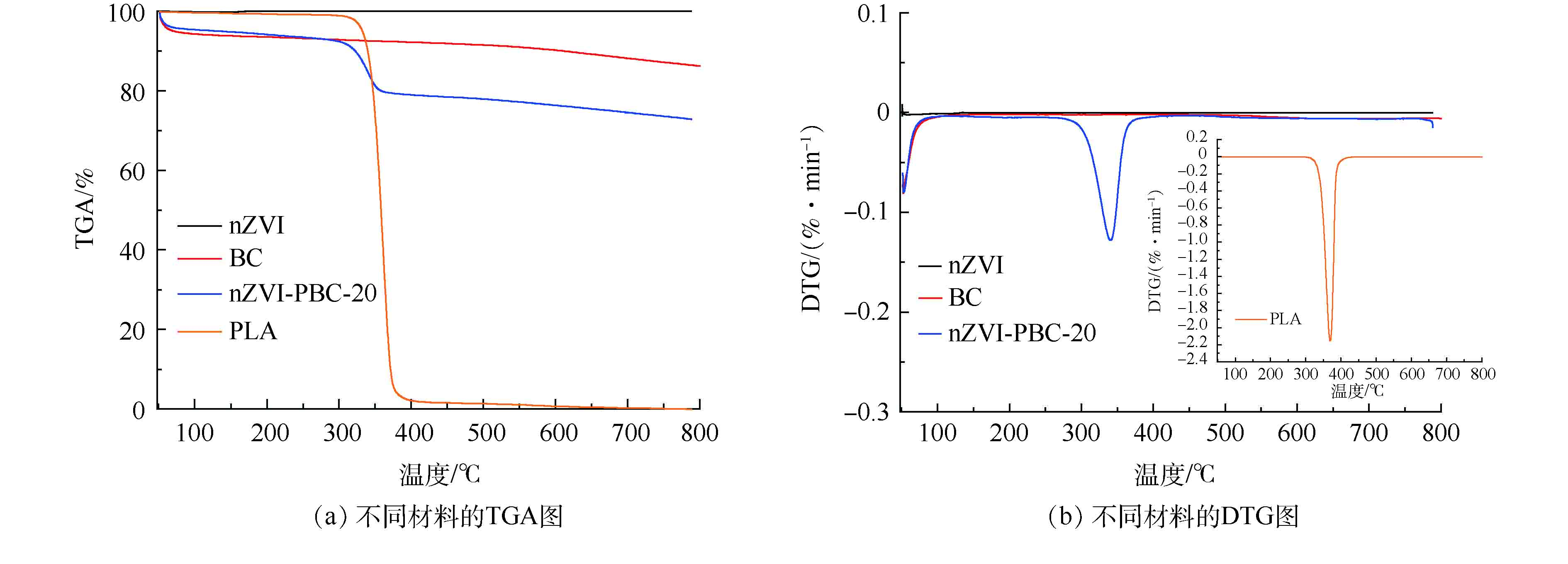
 下载:
下载:

